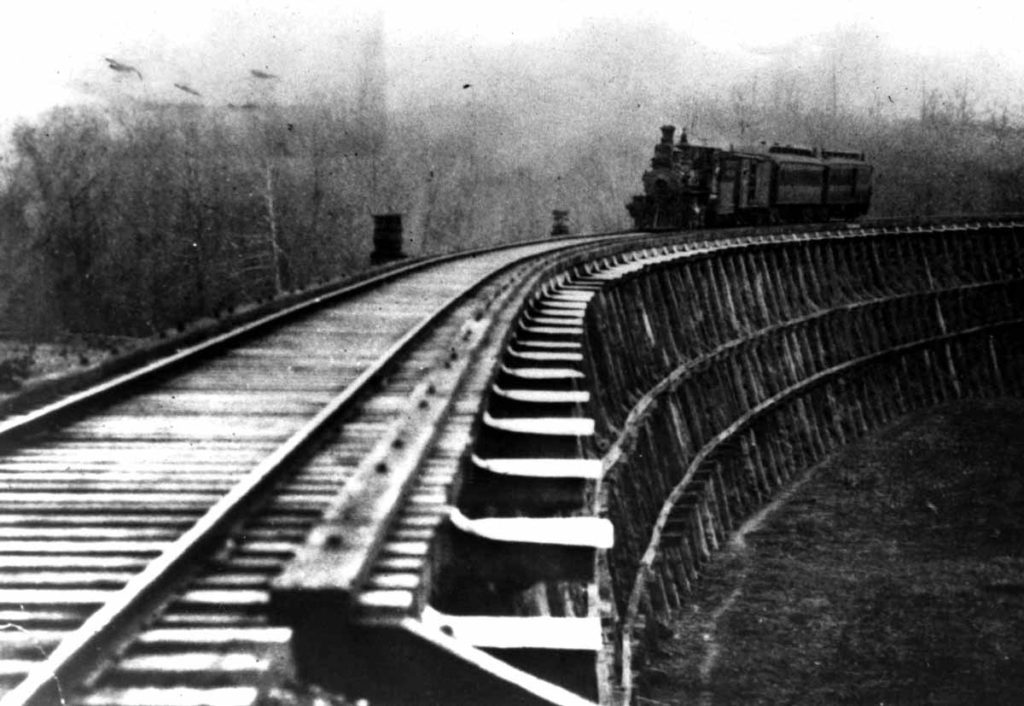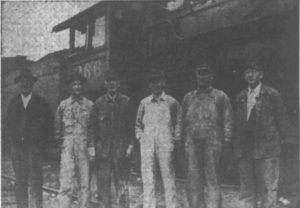from the research of Charles and Brenda Fiddler

This photo by Carl Partin shows the train on the curved trestle near Perryville, October 30, 1936. [Note Fleetwood Fesmire’s article says October 31, 1936.]
NASHVILLE BANNER article titled “Goodby to Perryville Branch” “The original name for the line was Tennessee Midland Railway. It extended from Memphis to Perryville via Lexington. It was started in 1887, and the line was finished in Perryville in 1889. The original plan was to extend the road to a point on the Virginia line. The Paducah, Tennessee and Alabama was built from Paducah to Lexington a few years later. The lines were bought by the present owners and operators. One train was operated on the Perryville branch line every day until it was discontinued.
Goodby to Perryville Branch
Nashville Banner, November 15, 1936
from the research of Jerry McDaniel
Thriving Towns Sprang Up Along Railroad, Originally Called Tennessee Midland
by Fleetwood Fesmire

From left to right are: P. H. Denison, conductor; W. H. Hodges, brakeman; W. H. Lindenfield, engineer; W. M. Gravey, brakeman; A. R. Attaway, flagman and U. G. Hearne, baggage man.
Before the day of hard surfaced highways, the coming of trucks and automobiles, the Perryville branch was a mutual asset to the railroad and the people, and very necessary. But with concrete, asphalt and graveled highways connecting towns and cities with the rural sections, it had become a losing investment to its owners.
The original name for the line was Tennessee Medland Railway. It extended from Memphis to Perryville via Lexington. It was started in 1887, and the line was finished to Perryville in 1889. The original plan was to extend the road to a point on the Virginia line. The Paducah, Tennessee and Alabama was built from Paducah to Lexington a few years later. The lines were bought by the present owners and operators. One train was operated on the Perryville branch line every day until it was discontinued. Up until the road was built from Paducah to Lexington trains were run from Memphis to Perryville.
Thriving Towns Spring Upon Line
The Perryville branch was responsible for a number of good towns springing up along its tracks in Henderson County and Decatur County. They are Warren’s Bluff, Chesterfield, Darden, Beacon, Parsons, and Perryville.
Warren’s Bluff was named for Dr. W. H. Warren, a prominent Lexington physician. Chesterfield was named in honor of Lloyd Chesterfield. Darden was named for Miles Darden, who was famed for being the world’s largest man, weighing about 1,000 pounds. Beacon was named for the Decatur County Beacon, which was established and edited by W. V. Barry, now publisher of the Lexington Progress and Clerk and Master of Henderson County. Parsons, largest town on the line and also the largest in Decatur County, was named for the Parsons family, and Perryville was named for Perry County. It was at one time the county seat of Perry County, when the boundary rearched far west of the river.
All of the station houses and lands on the Perryville branch have already been sold. Some of them will be torn down and moved away. The tracks will be taken up and moved.
Consolidation Brought Freights and Passengers
The building of the Tennessee Midland Railway in Henderson County was promoted by Judge W. W. Murray of Huntingdon and Josiah Patterson of Memphis. Henderson County subscribed and paid $75,000 for the construction. The consolidation with the Paducah, Tennessee and Alabama Road, resulted in freight and passenger trains between Paducah and Memphis. The original plan was to build the Paducah, Tennessee and Alabama from Paducah to some point in Alabama. But the plan was never carried out. When trains began operating between Memphis and Paducah, train service started from Lexington to Perryville. Then it was that the line was named the Perryville branch. T. J. Moss, a native of Hardin County was in charge of the building of the road from Paducah to Lexington.
The crew on the Perryville branch when it was discontinued were: P. H. Denison, passenger conductor; W. H. Hodges and W. M. Garvey, brakemen; W. H. Lindenfield, engineer; A. R. Attaway, freight conductor; and U. G. Hearne, baggageman. Mr. Dennison has thirty-nine years of service on the railroad to his credit, thirty-four years of it on the Perryville branch. Mr. Hodges hs twenty-seven years to his credit, with three and one-half years on the branch. Mr. Lindenfield has thirty-nine years of service with twenty-four year on the branch. Mr. Garvey has thirty-one years of service with fourteen years on the branch. Mr. Attaway has twenty-four years of service on the branch, and Mr. Hearne has had twenty-six years of service. All of these men were transferred to the main line of the N. C. & St. L. Railroad.
If the Perryville branch had been discontinued twenty years ago, it would have almost destroyed the towns up and down the line. But today it is different. Highway No. 20, a concrete paved road runs parallel with the railroad from Memphis to Nashville. Busses, trucks, and automobiles are running up and down this modern highway and delivering passengers and most of the necessities of life.
The Perryville branch will be missed by thousands of citizens in Henderson and Decatur Counties. Both counties will lose thousands of dollars of tax money, which has meant much to the economic progress and stability of both counties.
The citizens living in the goodly towns.
Did the Peavine Railroad run in Topton, NC or near there. My grandfather was a foreman in laying the Peavine Railroad Track in that area I am told. He has passed many, many years ago I would like to know more of the Peavine Railroad in that area. Marble, Andrews, Lake Junaluska ,Murphy, NC Do you have any information you could pass on to me about that time of the Peavine Railroad?
Hi Jean,
No, this was a branch railroad stretching from near Jackson, Tennessee to the Tennessee River in Decatur County, entirely in West Tennessee.
I think you are asking about a different Peavine Railroad. The one that I mapped was a local route between Lexington, TN and Perryville, TN. The total route is shown on the map.